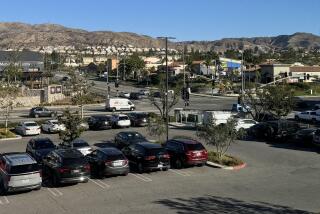Quake Drills Ready Schools For the Worst
- Share via
SANTA PAULA — A school clerk tumbles down a flight of stairs and dies after a skylight shatters in a major earthquake.
Search-and-rescue teams scour buildings searching for the injured. Middle school students are trapped in a second-story classroom.
“The door was lodged [shut] and they opened it with a pry bar,” Travis Tubbs, 13, one of the imprisoned students, said after the ordeal. “It was scary.”
Fortunately, it was also only a test.
Nearly 7,000 students, school officials and firefighters--almost a third of Santa Paula’s population--took part in an elaborate drill Friday morning to test disaster preparedness in the event of a major earthquake. It was the first such drill ever held at each of the Santa Paula Elementary School District’s schools and administration buildings.
Inadvertently held on the one-year anniversary of the Oklahoma City bombing--Wednesday’s rain had prompted a change in the originally scheduled day--the drill provoked the event’s lone “fatality” to express an appreciation for life.
“I thought I was helping out at the command center,” said Diane Wren, a 35-year-old mother of three. “Now I’m dead. I wasn’t ready to go, especially today, on the anniversary of that bombing. It’s eerie.”
*
But such a catastrophe is not considered a remote possibility considering the 1994 Northridge earthquake that devastated Fillmore, only eight miles to the east. Simi Valley’s schools sustained major damage in that quake, said Bret Breton, safety coordinator for Ventura County’s 20 school districts.
“If school had been in session [then] and it had happened at 11:30 in the morning, it would not have surprised me to see 200 to 500 fatalities and several hundred injuries,” he said.
The practical importance of being prepared aside, it’s also state law, Breton said. School districts are mandated to have such drills twice a year.
But in Ventura County, only 60% of districts are in compliance, he said. That could be costly in an actual cataclysm, in part because districts without the appropriate programs in place may not be eligible for government disaster-relief funds.
“That’s a pretty good incentive to do something,” Breton said.
But Santa Paula, which officials say has a reputation as one of the better-prepared districts in Southern California, did more than just something.
Never mind first-aid stations, most of the schools set up temporary morgues as well. Not content with ensuring the safety of human lives, preschoolers at the district’s child-care center also evacuated their pet rabbit.
And forget the occasional hysterical student, Blanchard School appointed an entire class of feverishly overacting fifth-graders.
“Five kids fine, but 30 kids [screaming] and never stopping was a bit much,” said school board member Bob Marzec, one of several people evaluating the schools’ disaster response plans.
There were some glitches.
A first-aid kit at Bedell School had rusted shut and proved useless. The same school discovered field mice had nibbled their way through its emergency food rations. Reluctant adults at one district office refused to duck and cover and demanded to know exactly how much a copier had supposedly moved to block a doorway.
And teachers at two separate schools discovered that they had forgotten their medications and ventured back into supposedly severely damaged buildings to retrieve their pills--a definite no-no even during such a drill.
“My first instinct was let him die,” an unsympathetic Breton said of one unfortunate instructor.
There were also some unexpected slices of realism.
A nervous parent at Blanchard School saw firefighters and immediately rushed to pick up her children, which at least gave officials the opportunity to put their student-release procedures to the test.
A couple of students broke out with heat rashes under the spring sun. But English teacher Bob Berg, a Korean War veteran whose hands held coffee, chocolate chip cookies and body bags, said the school must be ready for almost anything.
“I’ve seen military people panic, so you can imagine what would happen if this really goes down,” he said. “Some day it will probably happen, so it is good they have this kind of thing.”
All in all, Breton deemed it the best-conducted drill he had ever seen.
At Isbell Middle School, for instance, all employees and two-thirds of the 983 students are trained in first aid and cardiopulmonary resuscitation techniques. Sixty students assisted adults with first aid and communication duties. And orderly lines of students quietly evacuated to the school’s playing fields.
“We’re prepared,” said a confident Eileen Mora, 14. “We already know where the hazards are.”
More to Read
Sign up for Essential California
The most important California stories and recommendations in your inbox every morning.
You may occasionally receive promotional content from the Los Angeles Times.













